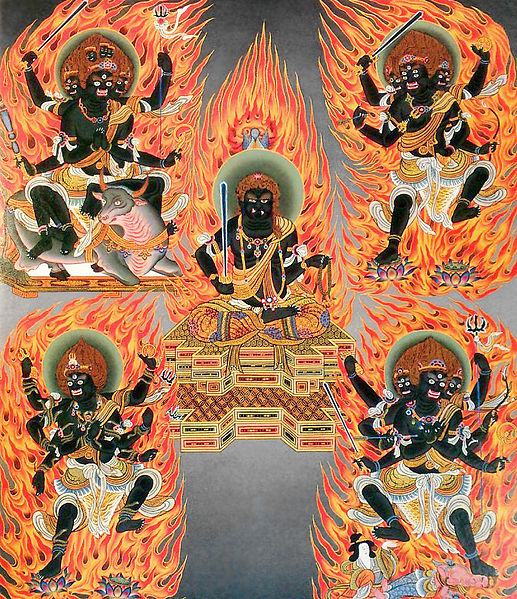
The Five Wisdom Kings and Five Wisdom Buddhas of Japanese Buddhism
Buddhism had great influence on the Japanese people throughout history. The practice of Buddhism peaked during the Kamakura and Muromachi periods where Buddhist institutions were used by the shogunate to control the country and its people. Buddhist temples also played a major administrative role during the Edo period via the Danka system (where families provide financial support for a Buddhist temple in exchange for their spiritual needs).
The Five Wisdom Kings, Japanese Buddhism.
This type of system required Japanese citizens to register at their local Buddhist temple in order to obtain a certification (uke) that was necessary for an individual to function in society.
The Five Wisdom Kings, the Kings of Brightness, or Myōō is a deity of Buddhism and is classed as the third after buddhas is the condition or rank of an “awakened one” and any person who is on the path towards Buddhahood. The Kings of Brightness are among the Buddhist deities imported from China to Japan in the early ninth century as part of Esoteric Buddhism. Esoteric Buddhism was believed to offer worldly and spiritual advantages that goes beyond what other forms of Buddhism can offer.
Myōō are steadfast protectors of the Buddhist Law and masters of channeling uncontrollable desires and allow them to turn into constructive conclusions. The Wisdom Kings mainly function as the guardians of Buddhism, and wrathful manifestations of Buddhas.
Buddha Amitābha whose wrathful manifestation is Daiitoku Myō-ō. | Daderot
The teachings of the Shingon tradition of Esoteric (various Buddhist traditions of Tantra and “Secret Mantra”) doctrine of the three chakra bodies, Wisdom Kings embody the wheel of injunction (kyōryō tenshin) and teach through fear, shocking nonbelievers into faith, as opposed to teaching through compassion as represented in pure concepts and bodhisattvas.
The Five Wisdom Buddhas
The Five Wisdom Kings represent the luminescent wisdom of the Buddha and protect the Five Wisdom Buddhas.
Gundari Myō-ō – “The Dispenser of Heavenly Nectar” – Wrathful manifestation of Buddha Ratnasambhava.
Fudō Myō-ō – “The Immovable One” – Wrathful manifestation of Buddha Mahavairocana.
Daiitoku Myō-ō – “The Defeater of Death” – Wrathful manifestation of Buddha Amitābha.
Kongōyasha Myō-ō – “The Devourer of Demons” – Wrathful manifestation of Buddha Amoghasiddhi.
Gozanze Myō-ō – “The Conqueror of The Three Planes” – Wrathful manifestation of Buddha Akshobhya.



